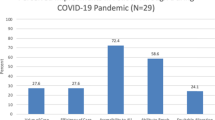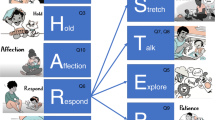Abstract
Objective:
Language exposure is important for neurodevelopment, but is sparse in the neonatal intensive care unit (NICU).
Study design:
We introduced Reach Out and Read (ROR) in the NICU as a quality improvement initiative to increase language exposure. Measures included availability of books, accessibility of parents, and enrollment of infants, percent infants read to by their parents, and data from parental surveys.
Result:
98 infants were included (40 before, 58 after). We obtained books in the mother’s language for 95% of infants, 82% eligible infants were enrolled, and 70% read to their infants (mean of 0.45 ± 0.35 times/day). Surveyed parents enjoyed reading, noted positive effect(s), and intended to read post-discharge.
Conclusion:
We launched a well-received pilot ROR program in the NICU and reached our goal of ≥50% infants being read to by their parents. Further study is needed to assess the impact of reading in the NICU on parents and infants.
This is a preview of subscription content, access via your institution
Access options
Subscribe to this journal
Receive 12 print issues and online access
$259.00 per year
only $21.58 per issue
Buy this article
- Purchase on Springer Link
- Instant access to full article PDF
Prices may be subject to local taxes which are calculated during checkout



Similar content being viewed by others
References
Caskey M, Stephens B, Tucker R, Vohr B. Importance of parent talk on the development of preterm infant vocalizations. Pediatrics. 2011;128:910–6.
Huttenlocher J. Language input and language growth. Prev Med. 1998;27:195–9.
Mayberry RI, Lock E, Kazmi H. Linguistic ability and early language exposure. Nature. 2002;417:38.
Briscoe J, Gathercole SE, Marlow N. Short-term memory and language outcomes after extreme prematurity at birth. J Speech Lang Hear Res. 1998;41:654–66.
Bohm B, Katz-Salamon M, Institute K, Smedler AC, Lagercrantz H, Forssberg H. Developmental risks and protective factors for influencing cognitive outcome at 5 1/2 years of age in very-low-birthweight children. Dev Med Child Neurol. 2002;44:508–16.
Vohr BR, Wright LL, Dusick AM, Mele L, Verter J, Steichen JJ, et al. Neurodevelopmental and functional outcomes of extremely low birth weight infants in the National Institute of Child Health and Human Development Neonatal Research Network, 1993-4. Pediatrics. 2000;105:1216–26.
Ortiz-Mantilla S, Choudhury N, Leevers H, Benasich AA. Understanding language and cognitive deficits in very low birth weight children. Dev Psychobiol. 2008;50:107–26.
Caskey M, Stephens B, Tucker R, Vohr B. Adult talk in the NICU with preterm infants and developmental outcomes. Pediatrics. 2014;133:e578–584.
Webb AR, Heller HT, Benson CB, Lahav A. Mother’s voice and heartbeat sounds elicit auditory plasticity in the human brain before full gestation. Proc Natl Acad Sci USA. 2015;112:3152–7.
Pineda RG, Neil J, Dierker D, Smyser CD, Wallendorf M, Kidokoro H, et al. Alterations in brain structure and neurodevelopmental outcome in preterm infants hospitalized in different neonatal intensive care unit environments. J Pediatr. 2014;164:52–60. e52
Hart B, Risley TR. Meaningful differences in the everyday experience of young American children. Baltimore, MD: P.H. Brookes; 1995.
Bus A, Van Ijzendoorn M, Pellegrini A. Joint book reading makes for success in learning to read: a meta-analysis of intergenerational transmission of literacy. Rev Educ Res. 1995;65:1–21.
Braid S, Bernstein J. Improved cognitive development in preterm infants with shared book reading. Neonatal Netw. 2015;34:10–17.
Yarosz D, Barnett W. Who reads to young children? Identifying predictors of family reading activities. Read Psychol. 2001;22:67–81.
Lariviere J, Rennick JE. Parent picture-book reading to infants in the neonatal intensive care unit as an intervention supporting parent-infant interaction and later book reading. J Dev Behav Pediatr. 2011;32:146–52.
Zuckerman B, Khandekar A. Reach Out and Read: evidence based approach to promoting early child development. Curr Opin Pediatr. 2010;22:539–44.
Council on Early C, High PC, Klass P. Literacy promotion: an essential component of primary care pediatric practice. Pediatrics. 2014;134:404–9.
Langley GL, Moen R, Nolan KM, Nolan TW, Norman CL, Provost LP. The Improvement Guide: A Practical Approach to Enhancing Organizational Performance. 2nd ed. San Francisco, CA: Jossey-Bass Publishers; 2009.
Perla RJ, Provost LP, Murray SK. The run chart: a simple analytical tool for learning from variation in healthcare processes. BMJ Qual Saf. 2011;20:46–51.
Acknowledgements
Funding
This work was supported by grants from Reach Out and Read of Massachusetts and the Cabot Family Charitable Trust, as well as the Boston Medical Center Elaine Ullian Fund.
Author information
Authors and Affiliations
Corresponding author
Ethics declarations
Conflict of Interest
All authors are responsible for this reported research. Dr. Levesque currently serves as a consultant to Reach Out and Read of Massachusetts to provide training for other neonatal intensive care units in Massachusetts who are interested in introducing Reach Out and Read in their units. Alison Corning-Clarke and Carole Ferguson are both employed by Reach Out and Read of Massachusetts. The remaining authors declare that they have no conflict of interest.
Electronic supplementary material
Rights and permissions
About this article
Cite this article
Levesque, B.M., Tran, A., Levesque, E. et al. Implementation of a pilot program of Reach Out and Read® in the neonatal intensive care unit: a quality improvement initiative. J Perinatol 38, 759–766 (2018). https://doi.org/10.1038/s41372-018-0060-8
Received:
Revised:
Accepted:
Published:
Issue Date:
DOI: https://doi.org/10.1038/s41372-018-0060-8
This article is cited by
-
Chronic pediatric diseases and risk for reading difficulties: a narrative review with recommendations
Pediatric Research (2022)
-
I can’t breathe
Journal of Perinatology (2021)
-
Visitation restrictions: is it right and how do we support families in the NICU during COVID-19?
Journal of Perinatology (2020)



